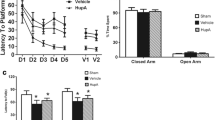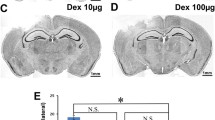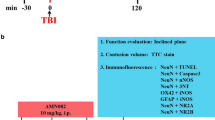Abstract
Memantine is an uncompetitive N-methyl-D-aspartate (NMDA) receptor antagonist. Unlike other NMDA antagonists, it has been used clinically for years for the treatment of Parkinson’s disease, spasticity, and dementia without serious side effects. We aimed to investigate the therapeutic efficacy of memantine on a closed head trauma model. A total of 132 adult male Sprague–Dawley rats were randomly divided into four groups: sham-operated, control (closed head trauma), sham-vehicle (closed head trauma + saline), treatment (closed head trauma + memantine, 10 mg/kg, i.p.). A cranial impact was delivered to the skull, just in front of the coronal suture, over the left hemisphere, from the height of 7 cm. Saline or memantine were applied 15 min after trauma. Rats were euthanased 0.5, 1, 2, 6, 24, 48 h after trauma. Brain tissue samples were taken 5 mm away from the left frontal pole and also from the corresponding point of the contralateral hemispheres. Malondialdehyde activity (MDA) was considered to reflect the degree of lipid peroxidation. The MDA levels continued to increase for the first 2 h after the injury, then started to decrease gradually. Memantine treatment significantly reduced lipid peroxidation levels in the treatment group compared with other groups (P<0.01). The findings of the present study indicate that memantine provides beneficial effects after closed head trauma in rats.
Similar content being viewed by others
References
Baethmann A, Maier-Hauff K, Schurer L, Large M, Guggenbichler C, Vogt W (1989) Release of glutamate and free fatty acids in vasogenic brain edema. J Neurosurg 70:578–591
Blandpied TA, Boeckman FA, Aizenman E, Johnson JW (1992) Trapping channel block of NMDA-activated responses by amantadine and memantine. J Neurophysiol 77:309–323
Block F, Schwarz M (1996) Memantine reduces functional and morphological consequences induced by global ischemia in rats. Neurosci Lett 208:41–44
Bormann J (1989) Memantine is a potent blocker of N-methyl-D-aspartate (NMDA) receptor channels. Eur J Pharmacol 166:591–592
Chen HS, Lipton SA (1997) Mechanism of memantine block of NMDA-activated channels in rat retinal ganglion cells: uncompetitive antagonism. J Physiol 499:27–46
Chen HV, Pellegrini JW, Aggarwal SK, Lei SZ, Warach S (1992) Open-channel block N-methyl-D-aspartate (NMDA) responses by memantine. Therapeutic advantage agonist NMDA receptor-mediated neurotoxicity. J Neurosci 12:4427–4436
Choi DW (1988) Glutamate neurotoxicity and diseases of the nervous system. Neuron 1:623–634
Cristofori L, Tavazzi B, Gambin R, Vagnozzi R, Vivenza C, Amorini AM (2001) Early onset of lipid peroxidation after human traumatic brain injury: a fatal limitation for the free radical scavenger pharmacological therapy. J Investig Med 49:450–458
Faden AI, Demediuk P, Panter SS, Vink R (1989) The role of excitatory aminoacids and NMDA receptors in traumatic brain injury. Science 244:798–800
Görgülü A, Kırış T, Çobanoğlu S, Ünal F, İzgi N, Yanık B, Küçük M (2000) Reduction of edema and infarction by memantine and MK-801 after focal cerebral ischemia and reperfusion in rat. Acta Neurochir (Wien) 42:1287–1292
Görgülü A, Kırış T, Ünal F, Türkoğlu Ü, Küçük M, Çobanoğlu S (1999) Protective effect of the N-methyl-D-aspartate antagonists MK-801 and CPP on cold-induced brain oedema. Acta Neurochir (Wien) 141:93–98
Hsiang JN, Wang JV, Ip SM, Stadlin A, Yu AL, Poon WS (1997) The time course and regional variations of lipid peroxidation after diffuse brain injury in rats. Acta Neurochir (Wien) 139:464–468
Ikeda Y, Long DM (1990) The molecular basis of brain injury and brain edema: the role of oxygen free radicals. Neurosurgery 27:1–11
Kanthan R, Shuaib A (1995) Clinical evaluation of extracellular amino acids in severe head trauma by intracerebral in vivo microdialysis. J Neurol Neurosurg Psychiatry 59:326–327
Kaplanski J, Asa I, Artru AA, Azez A, Ivashkova Y, Rudich Z, Pruneau D, Shapira Y (2003) LF0687 Ms, a new bradykinin B2 receptor antagonist, decreases ex vivo brain tissue prostaglandin E2 synthesis after closed head trauma in rats. Resuscitation 56:207–213
Katayama Y, Becker DP, Tamura T, Hovda DA (1990) Massive increases in extracellular potassium and the indiscriminate release of glutamate following concussive brain injury. J Neurosurg 73:889–900
Kemp JA, Foster AC, Wong EHF (1987) Non-competitive antagonists of excitatory amino acid receptors. Trends Neurosci 10:294–298
Koek W, Woods JH, Winger GD (1988) MK-801, a proposed non-competitive antagonists of excitatory amino acid neurotransmission, produces phencylidine-like behavioral effects in pigeons, rats and rhesus monkeys. J Pharmacol Exp Ther 245:969–974
Koura SS, Doppenberg EM, Marmarou A, Choi S, Young HF (1998) Relationship between excitatory amino acid release and outcome after severe human head injury. Acta Neurochir (Wien) 7:244–246
Kuchiwaki H, Inao S, Yamamoto M, Yoshida K, Sugita K (1994) An assessment of progression of brain edema with amino acid levels in cerebrospinal fluid and charges in electroencephalogram in an adult cat model of cold brain injury. Acta Neurochir (Wien) 60:62–64
Lowry OH, Rosenbrought NJ, Farr AL (1951) Protein measurement with the folin phenol reagents. J Biol Chem 193:265–277
Marshall LF (2000) Head injury: recent past, present, and future. Neurosurgery 47:546–561
Nasr MS, Peruche B, Robberg C, Mennel HD, Krieglstein J (1990) Neuroprotective effect of memantine demonstrated in vivo and vitro. Eur J Pharmacol 185:19–24
Marshall LF, Maas AI, Marshall SB, Bricolo A, Fearnside M, Iannotti F, Klauber MR, Lagarrigue J, Lobato R, Persson L, Pickard JD, Piek J, Servadei F, Wellis GN, Morris GF, Means ED, Musch B (1998) A multicenter trial on the efficacy of using tirilazad mesylate in cases of head injury. J Neurosurg 89:519–525
McCall JM, Braughler JM, Hall ED (1987) Lipid peroxidation and the role of oxygen radicals in CNS injury. Acta Anaesthesiol Belg 38:373–379
McIntosh TK, Vink R, Soares H, Hayes R, Simon R (1990) Effect of non-competitive blockade of N-methyl-D-aspartate receptor on the neurochemical sequelae of experimental brain injury. J Neurochem 55:1170–1179
Nilsson P, Hillerd L, Ponten U, Ungerstedt U (1990) Charges in cortical extracellular levels of energy-related metabolites and amino acids following concussive brain injury in rats. J Cereb Blood Flow Metab 10:631–637
Ohkawa H, Ohishi N, Yagi K (1979) Assay for lipid peroxides in animal tissues by thiobarbituric acid reaction. Anal Biochem 95:351–358
Orgogozo JM, Rigaud AS, Stoffler A, Mobius HJ, Forette F (2002) Efficacy and safety of memantine in patients with mild to moderate vascular dementia: a randomized, placebo-controlled trial. Stroke 33:1834–1839
Paolin A, Nardin L, Gaetani P, Rodriguez Y, Baena R, Pansarasa O, Marzatico F (2002) Oxidative damage after severe head injury and its relationship to neurological outcome. Neurosurgery 51:949–954
Pellegrini JW, Lipton SA (1993) Delayed administration of memantine prevents N-methyl-D-aspartate receptor-mediated neurotoxicity. Ann Neurol 33:403–407
Rothman SM, Olney JW (1986) Glutamate and the pathophysiology of hypoxic–ischemic brain damage. Ann Neurol 19:105–111
Rao VL, Dogan A, Todd KG, Bowen KK, Dempsey RJ (2001) Neuroprotection by memantine, a non-competitive NMDA receptor antagonist after traumatic brain injury in rats. Brain Res 911:96–100
Sang CN, Booher S, Gilron I, Parada S, Max MB (2002) Dextromethorphan and memantine in painful diabetic neuropathy and postherpetic neuralgia. Anesthesiology 96:1053–1061
Scatton B, Carter C, Benavidas J, Giroux C (1991) N-methyl-D-aspartate receptor antagonists: a novel therapeutic perspective for the treatment of ischemic brain injury. Cerebrovasc Dis 1:121–135
Schmidley JW (1990) Free radicals in central nervous system ischemia. Stroke 21:1086–1090
Shapira Y, Shohami E, Sidi A, Soffer D, Freeman S, Cotev S (1988) Experimental closed head injury in rats: mechanical, pathophysiologic and neurologic properties. Crit Care Med 16:258–265
Shapira Y, Yadid G, Cotev S, Niska A, Shohami E (1990) Protective effect of MK-801 in experimental brain injury. J Neurotrauma 7:131–139
Siesjö BK (1993) Basic mechanisms of traumatic brain damage. Ann Emerg Med 22:959–969
Soffel M, Eriskat J, Plesnila M, Aggrawal N, Baethman A (1997) The penumbra zone of a traumatic cortical lesion: a microdialysis study of excitatory amino acid release. Acta Neurochir (Wien) 70:91–93
Tanaka H, Katayama Y, Kawamata T, Tsubobawa T (1994) Excitatory amino acid release from contused brain tissue in to surrounding brain areas. Acta Neurochir (Wien) 60:524–527
Uchida K, Nakakimura K, Kuroda Y, Haranishi Y, Matsumoto M, Sakabe T (2001) Dizocilpine but not Ketamine reduces the volume of ischaemic damage after acute subdural haematoma in the rat. Eur J Anaesthesiol 18:295–302
Üstün ME, Gürbilek M, Ak A, Vatansever H, Duman A (2001) Effect of magnesium sulfate on tissue lactate and malondialdehyde levels in experimental head trauma. Intensive Care Med 27:264–268
Vagnozzi R, Marmarou A, Tavazzi B, Signoretti S, Di Pierro D, Del Bolgia F, Amorini AM, Fazzina G, Sherkat S, Lazzarino G (1999) Changes of cerebral energy metabolism and lipid peroxidation in rats leading to mitochondrial dysfunction after diffuse brain injury. J Neurotrauma 16:903–913
Weller M, Finiels-Marlier F, Paul SM (1993) NMDA receptor-mediated glutamate toxicity of cultured cerebellar, cortical and mesencephalic neurons: neuroprotective properties of amantadine and memantine. Brain Res 613:143–148
Author information
Authors and Affiliations
Corresponding author
Rights and permissions
About this article
Cite this article
Özsüer, H., Görgülü, A., Kırış, T. et al. The effects of memantine on lipid peroxidation following closed-head trauma in rats. Neurosurg Rev 28, 143–147 (2005). https://doi.org/10.1007/s10143-004-0374-1
Received:
Accepted:
Published:
Issue Date:
DOI: https://doi.org/10.1007/s10143-004-0374-1




